There are hundreds of things you can do to get higher Google rankings.
But it’s important to get the basics down first.
In other words:
You want to make sure that your site follows current SEO best practices. That’s the foundation.
What Are SEO Best Practices?
SEO best practices are tasks designed to help improve a website’s rankings.
Common search engine optimization best practices include on-site optimization, researching keywords, and building backlinks to a site.
In fact, only 63% of Google searchers ever click on something from the second page of search results. Which is why it’s so essential to rank on the first page of Google.
You can put your best foot forward by following SEO best practices.
With that, here are the 9 most important ones you need to know.
1. Align Your Content with Search Intent
Search intent (also called “user intent”) is the purpose behind every search query.
Understanding and satisfying search intent is Google’s ultimate priority. Pages that rank on the first page have all passed Google’s test on search intent.
For instance, take a look at the search results for “how to make oatmeal cookies.”
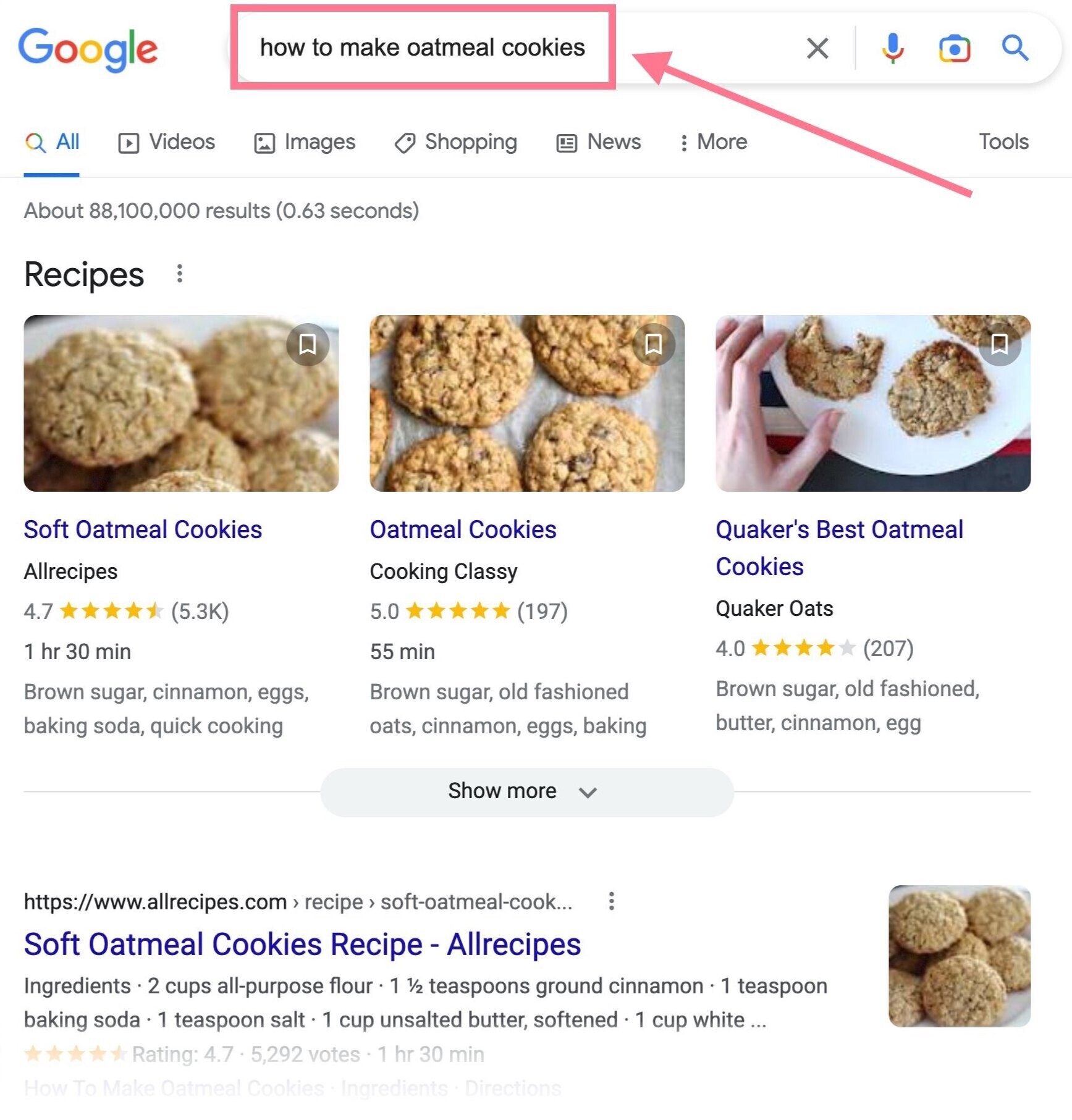
The top search results are blog posts or videos. Not ecommerce pages selling oatmeal cookies.
Google understands that people who are searching for this keyword are looking to learn. Not to buy.
On the other hand, the results for a query like “buy oatmeal cookies” are product ads and ecommerce pages.
Like this:
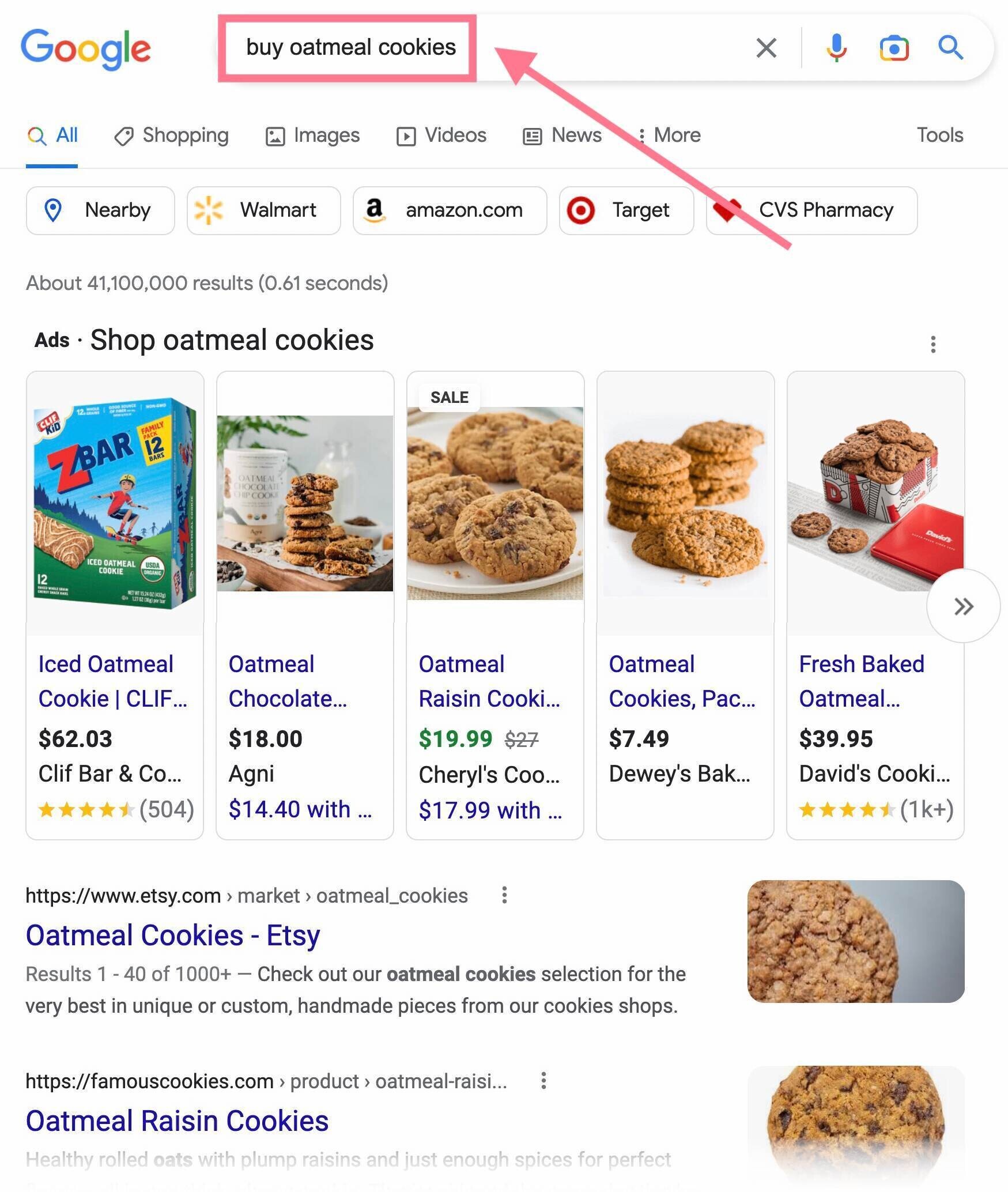
In this case, Google understands that people are looking to buy. Hence, no links to oatmeal cookie recipes.
Which means:
If you’d like to rank on page 1 of Google, you need to understand search intent and create content that matches it.
There are four common types of search intent:
- Informational: when someone is trying to learn more about something
- Navigational: when someone is searching for a specific page or website
- Commercial: when someone is looking to learn more before making a purchase
- Transactional: when someone is intending to complete an action or purchase
To quickly find a keyword’s intent, head to Semrush’s Keyword Overview tool.
Enter your keyword, hit search, and you’ll see a box labeled “Intent.”
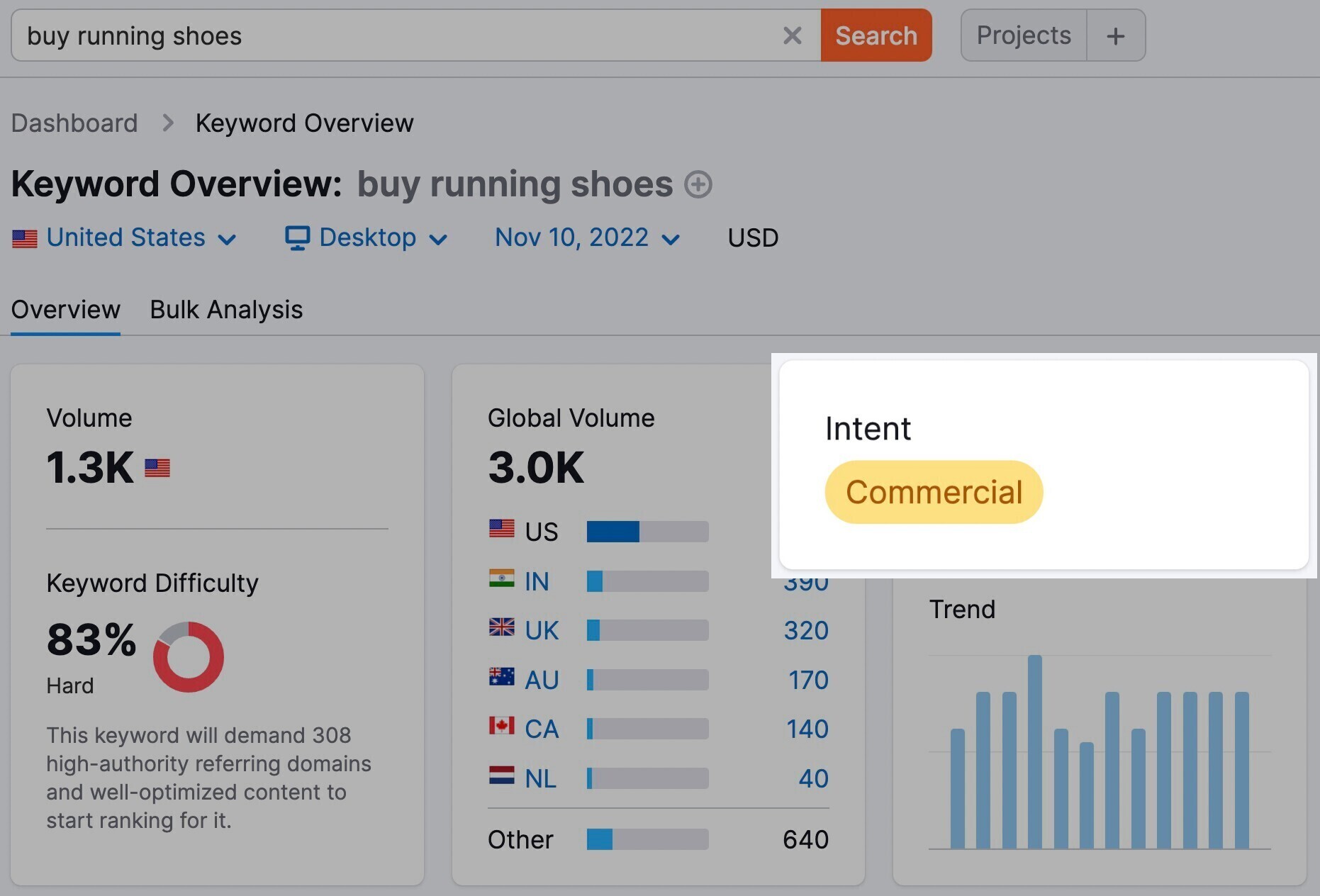
Your page title and meta description are two of the most important meta tags on your page.
Title Tags
Title tags are clickable headlines that appear in SERPs (search engine results pages).
They signal to Google what your page is about. And they’re fundamental from an SEO perspective.
This is what a title tag looks like in Google’s search results:
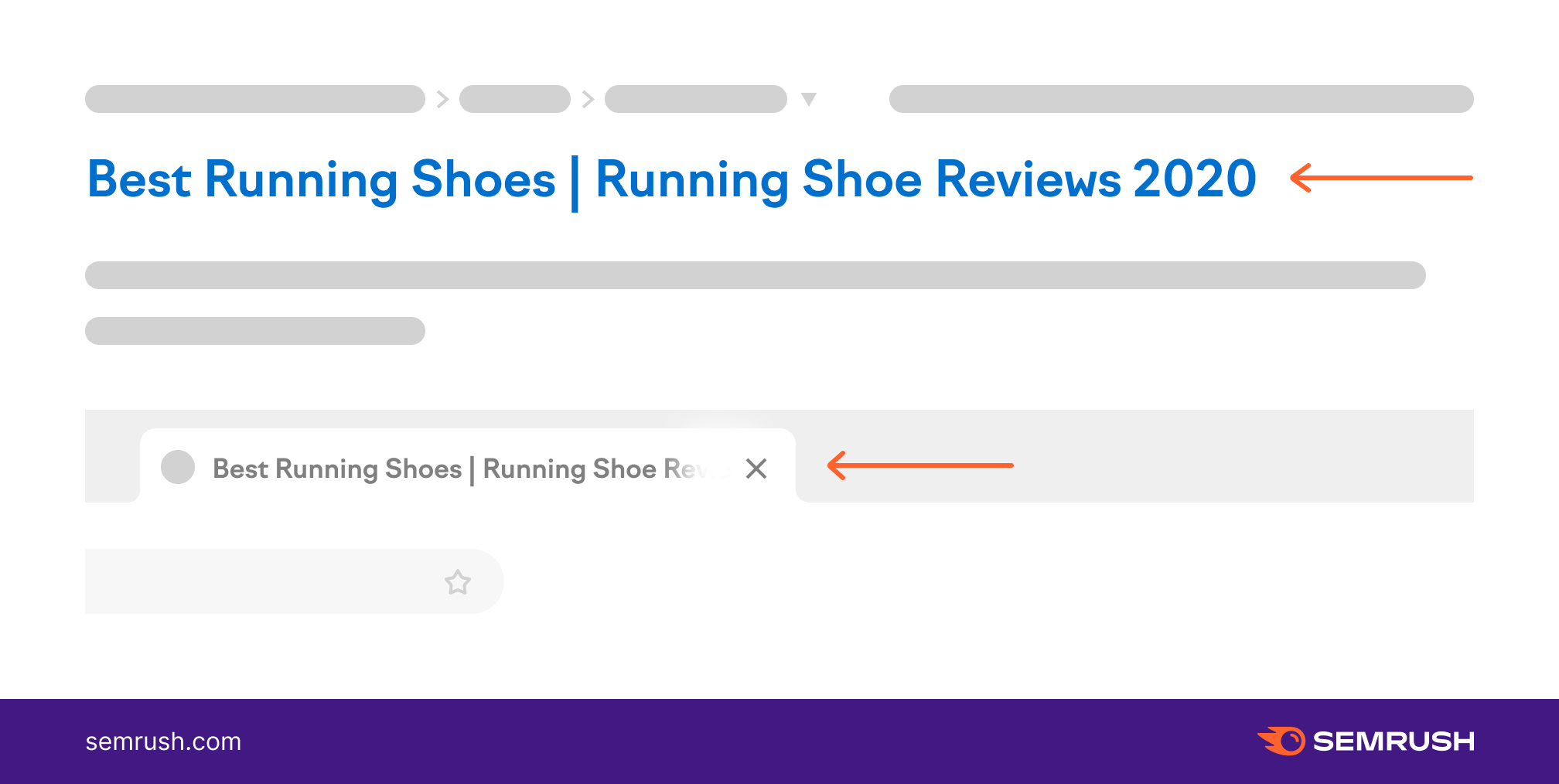
Title tags are critical to giving users a quick insight into the content of a result. And why it’s relevant to their query.
It’s often the primary piece of information searchers use to decide which result to click on.
So, it’s important to use compelling titles for your web pages.
Generally, it’s best to keep title tags between 50 to 60 characters. This way, words won’t get cut off on desktop or mobile SERPs.
Here are some other title tag best practices to keep in mind:
- Include your target keyword
- Match search intent
- Avoid duplicate title tags
- Avoid keyword stuffing
- Keep it descriptive but concise
Meta Descriptions
A meta description is a meta tag used to describe the content of a page.
It’s often displayed below the title and URL of your page in the SERP.
Like so:
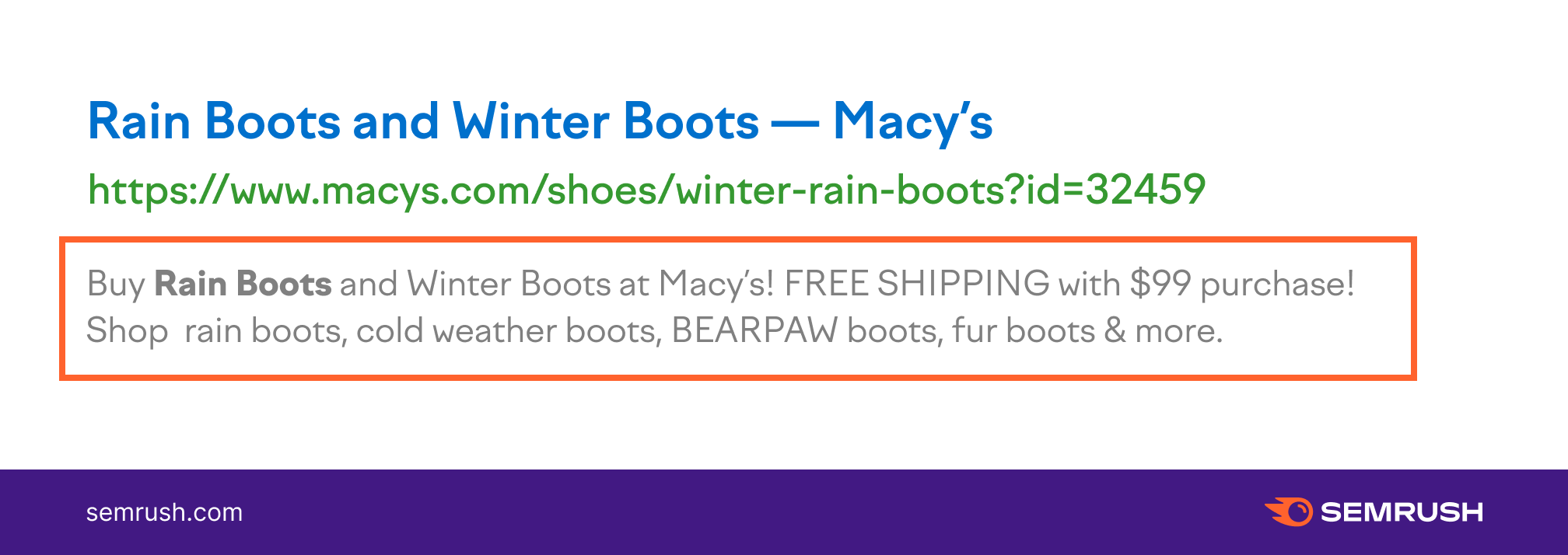
Meta descriptions should generally inform and interest users with a short, relevant summary of what the page is about.
They’re like a pitch that convinces a searcher that the page is exactly what they’re looking for.
Google typically truncates meta descriptions to 155–160 characters.
So, make sure your summary is accurate and succinct.
Here are a few meta description best practices to follow:
- Write a unique meta description for every page
- Use action-oriented copy
- Include your target keyword
- Match search intent
3. Optimize Your Images
Images play a crucial role in improving a visitor’s user experience.
When used the right way, images can contribute to your site’s overall SEO and boost organic traffic.
Here are four ways to optimize your images:
1. Choose the Best File Format
Images are often the largest contributor to overall page size and loading time. And page speed is an important ranking factor.
The first step is picking the best file format.
The most commonly used image formats on the web are JPEG and PNG.
Both formats use different compression techniques. Which is why the file sizes between these two can be dramatically different.
Like so:
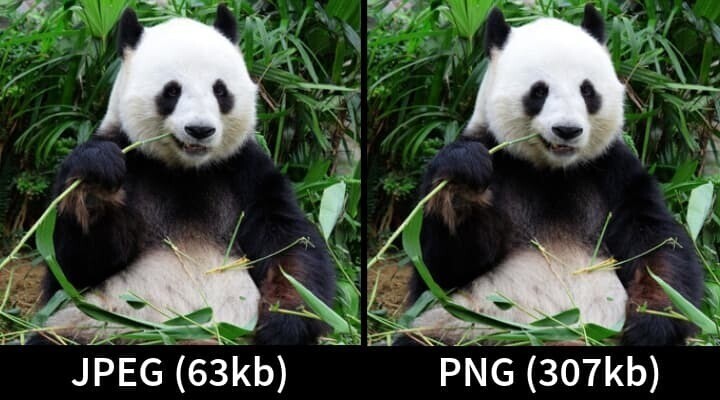
Looking at the difference in file sizes above, it would be easy to declare JPEG as the winner. But it would be a mistake.
While JPEGs look great for photographs, PNGs are best suited for images that contain text, line drawings, etc.
WebP is another popular option. It’s a modern image format that provides superior lossless and lossy compression for web images.
According to Google, WebP lossless images are 26% smaller in size compared to PNGs and 34% smaller than comparable JPEGs.
Learn more about how to use WebP in this Google guide.
2. Compress Your Images
Image compression is a process applied to images to minimize their size without degrading quality.
The larger your image file size, the longer it takes your page to load.
So it’s really important to compress your images before you upload them to your site.
Here are several free tools that can help:
- TinyPNG: uses smart lossy compression techniques to reduce the file size of your PNG and JPEG files
- ImageOptim: by far the best tool for compressing images on a Mac
- ShortPixel: a great WordPress plugin for automatically compressing images
3. Provide Alt Text for Images
Alt text (short for alternative text) is text included in HTML code to describe an image on a webpage.
It provides context for search engine crawlers as well as for those viewing a page with a screen reader.
Despite advances in Google’s ability to understand images, adding alt text to images is still necessary.
Here are several alt text best practices to follow:
- Keep it under 125 characters
- Include one main keyword for context
- Don’t include “image of” or “picture of”
To find and fix missing alt text, use Semrush’s Site Audit tool.
Start by creating a project and then clicking on the “Issues” tab.
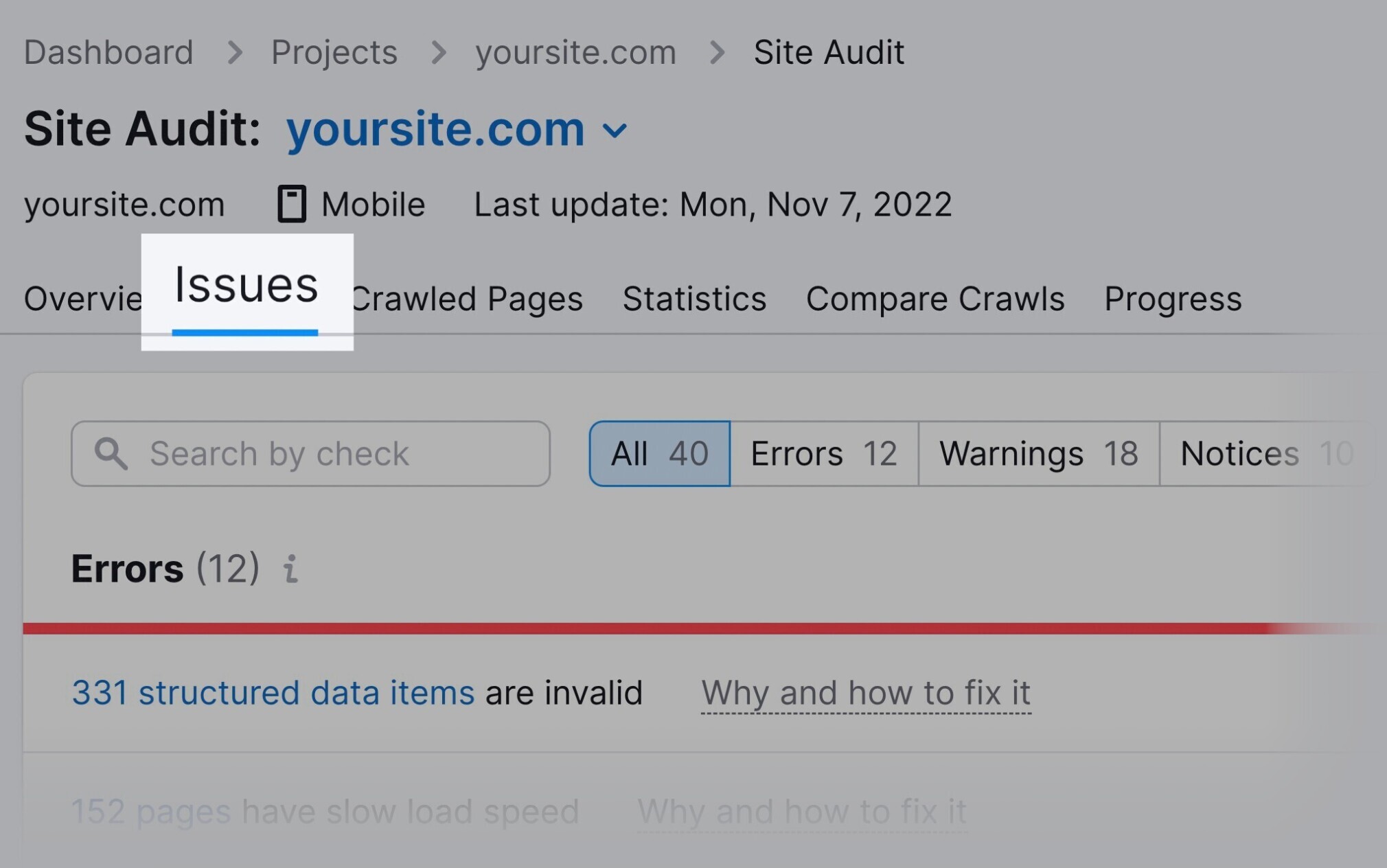
Then, narrow down your results by searching for “alt attributes” only.
Like so:

Now you can see exactly which images are causing the issue so you can log in to your site and fix them.
4. Lazy-Load Your Images
Lazy loading is a technique in app and web development that defers the loading of non-critical resources (images, videos, etc.) at page load time.
Images and videos are loaded only when users need them.
Here’s how Google explains the link between lazy loading and site performance:
“When we lazy load images and video, we reduce initial page load time, initial page weight, and system resource usage, all of which have positive impacts on performance.”
4. Optimize Your Site’s Page Loading Speed
Google considers site loading speed a primary ranking factor. Especially on mobile.
Which is why we recommend making your site load as quickly as possible.
To benchmark your site’s current loading speed, use Google’s own PageSpeed Insights tool.
Start by entering your URL, and then clicking “Analyze.”
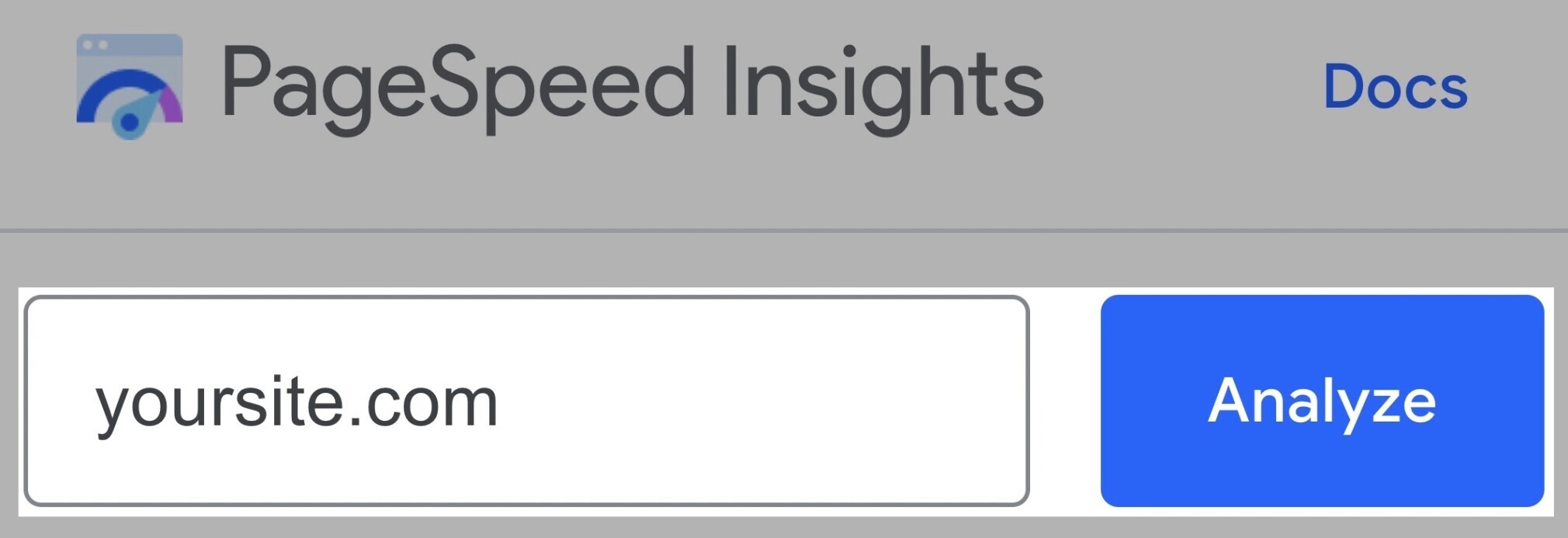
You’ll see a dashboard with your site’s overall health. And a detailed report with all the ways you can improve.
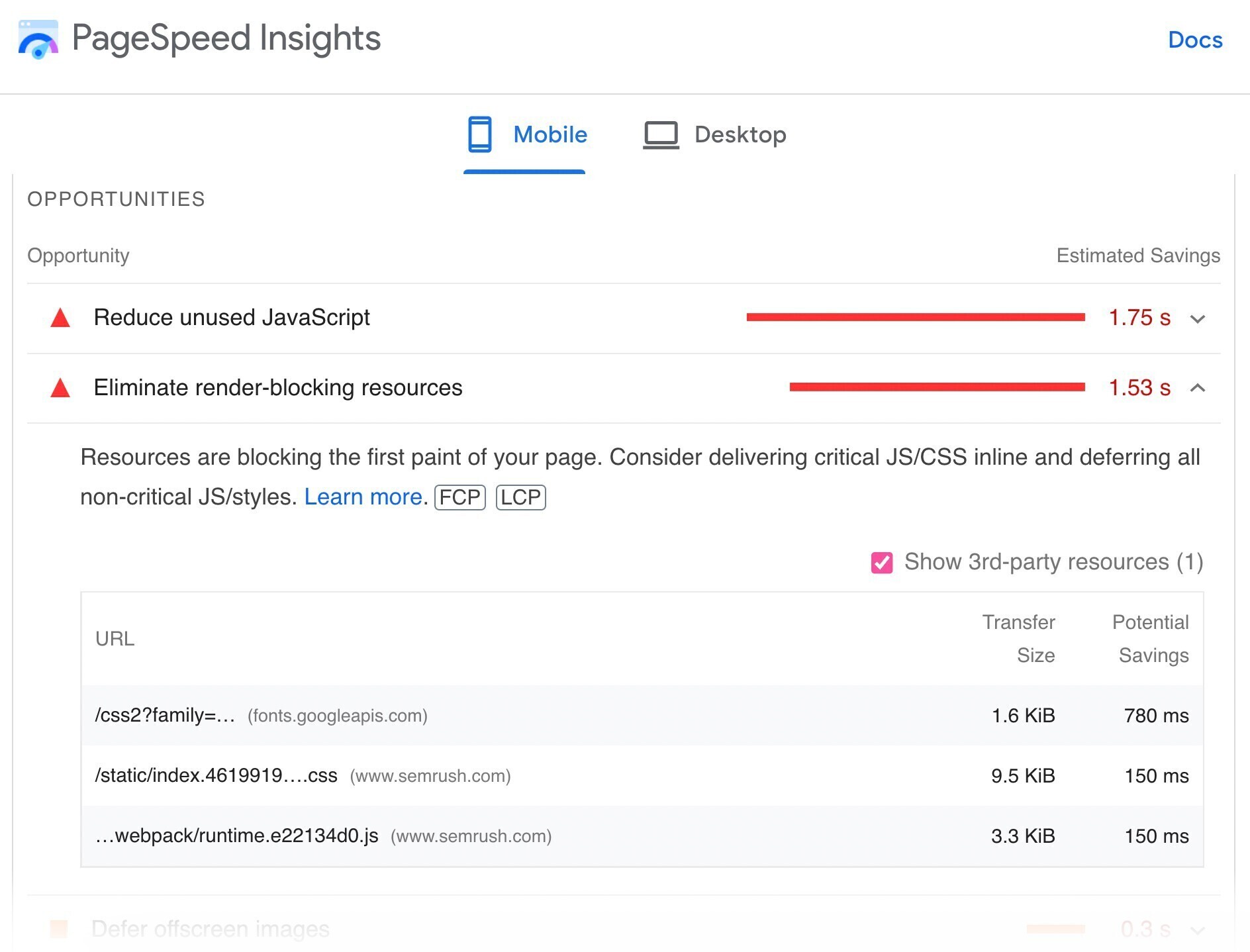
To dig deeper, use our Site Audit tool.
First, create a new project (if you haven’t already done so). And look for “Site Performance” and click on “View details.”
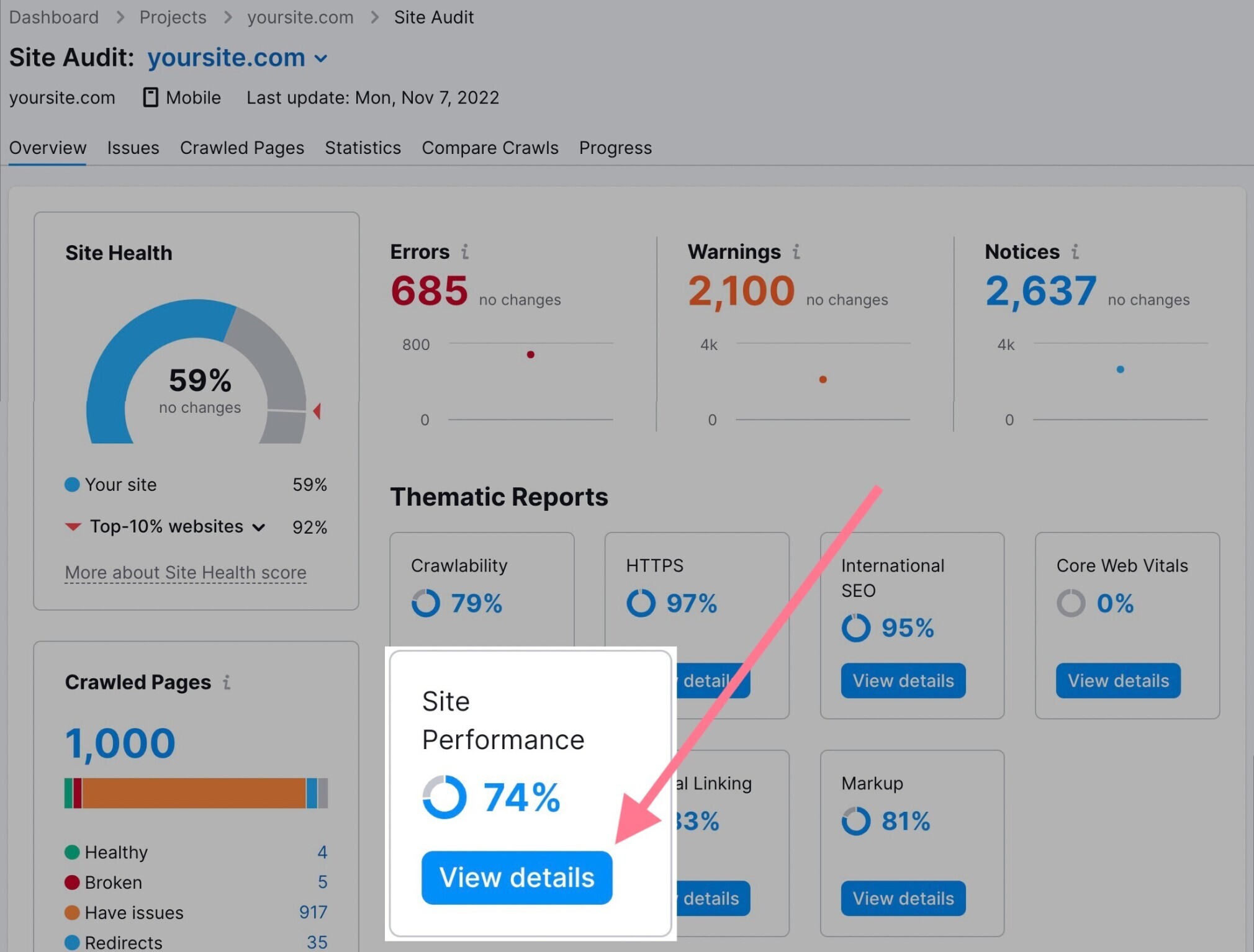
Then, see and address all the errors and warnings under “Performance Issues.”
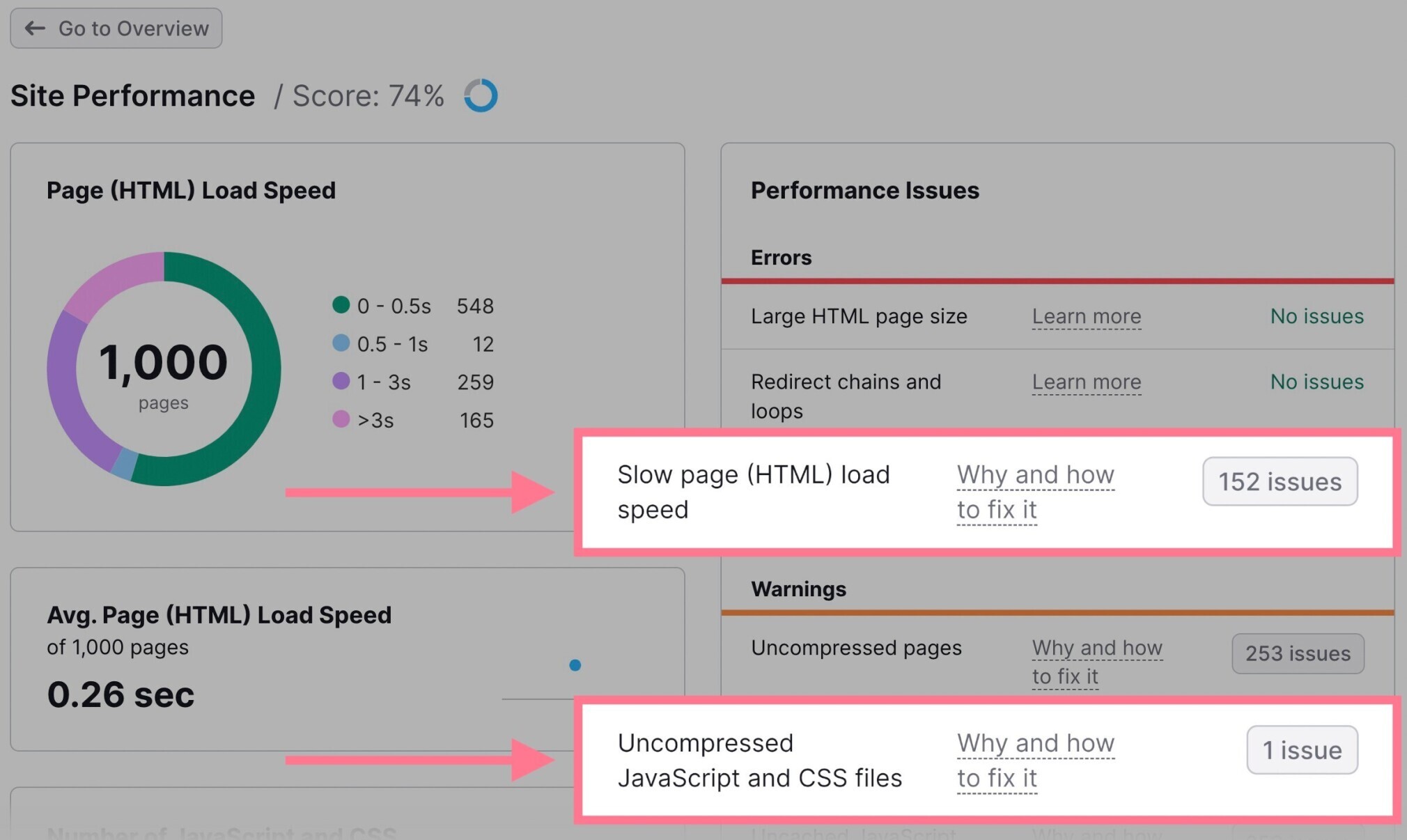
These are all the issues on your site that are preventing it from loading faster.
You can also click on “# issues” to see more about the issue and how to fix it.
You’ll see a list of URLs and their load times.
Like this:
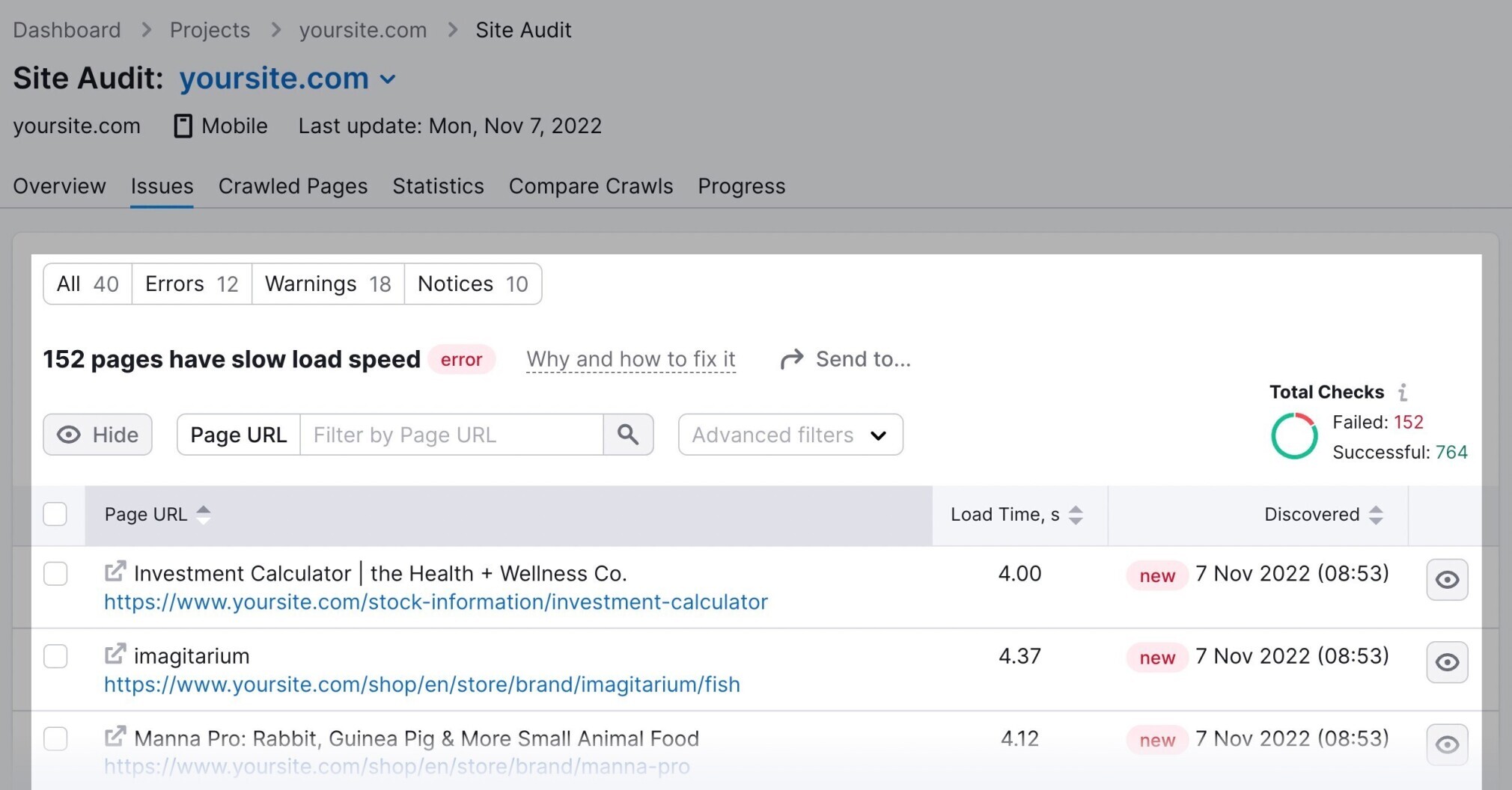
5. Build an Internal Linking Structure
Internal links are important because they establish an information hierarchy for your website. And help Google understand the content on your page.
When used the right way, internal links may have the ability to boost your rankings.
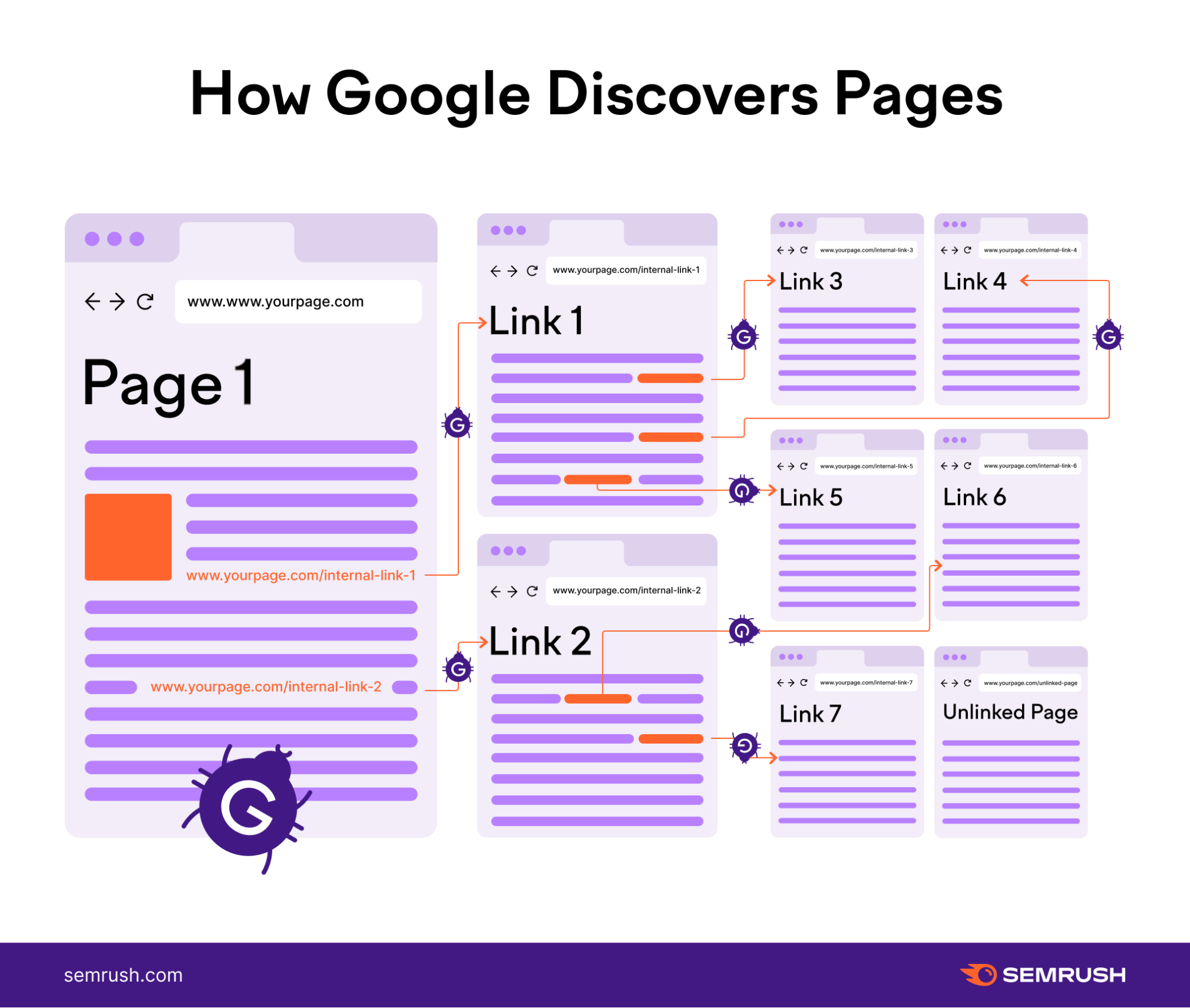
An SEO best practice is to add internal links from top-ranking pages on your site to pages that need a boost.
Generally, this means linking old pages (that perform well) to new ones. Old pages tend to have more authority.
It’s a nice shortcut to help you use internal links without having to analyze every page on your site.
That being said, you should still look out for internal linking errors. They can be detrimental to your SEO.
To quickly find and fix these errors, use the internal linking report within our Site Audit tool.
Again, start by creating your project if you haven’t already, and look for the “Internal Linking” box.
And click on “View details.”
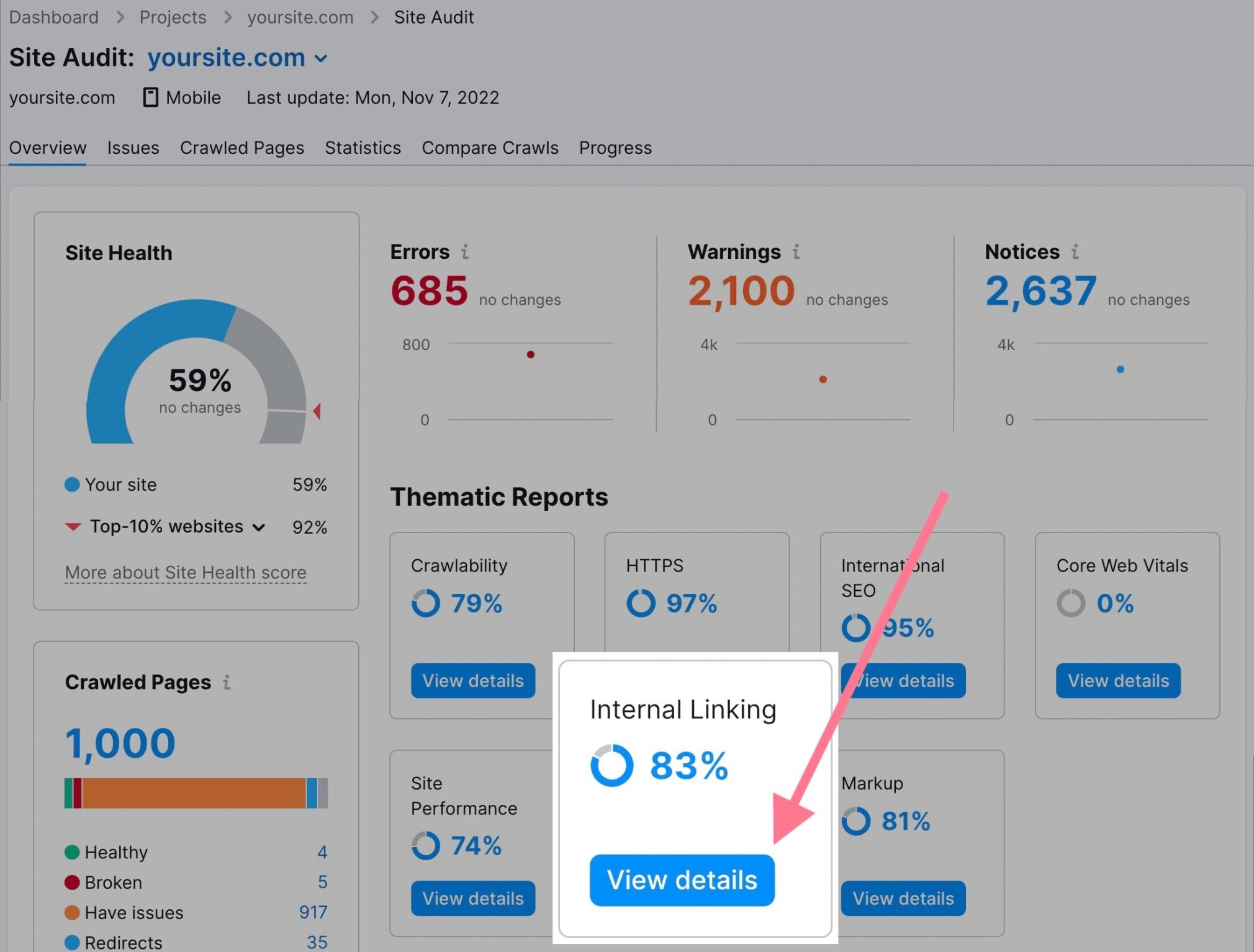
Then, see and address all errors and warnings under “Internal Link Issues.”
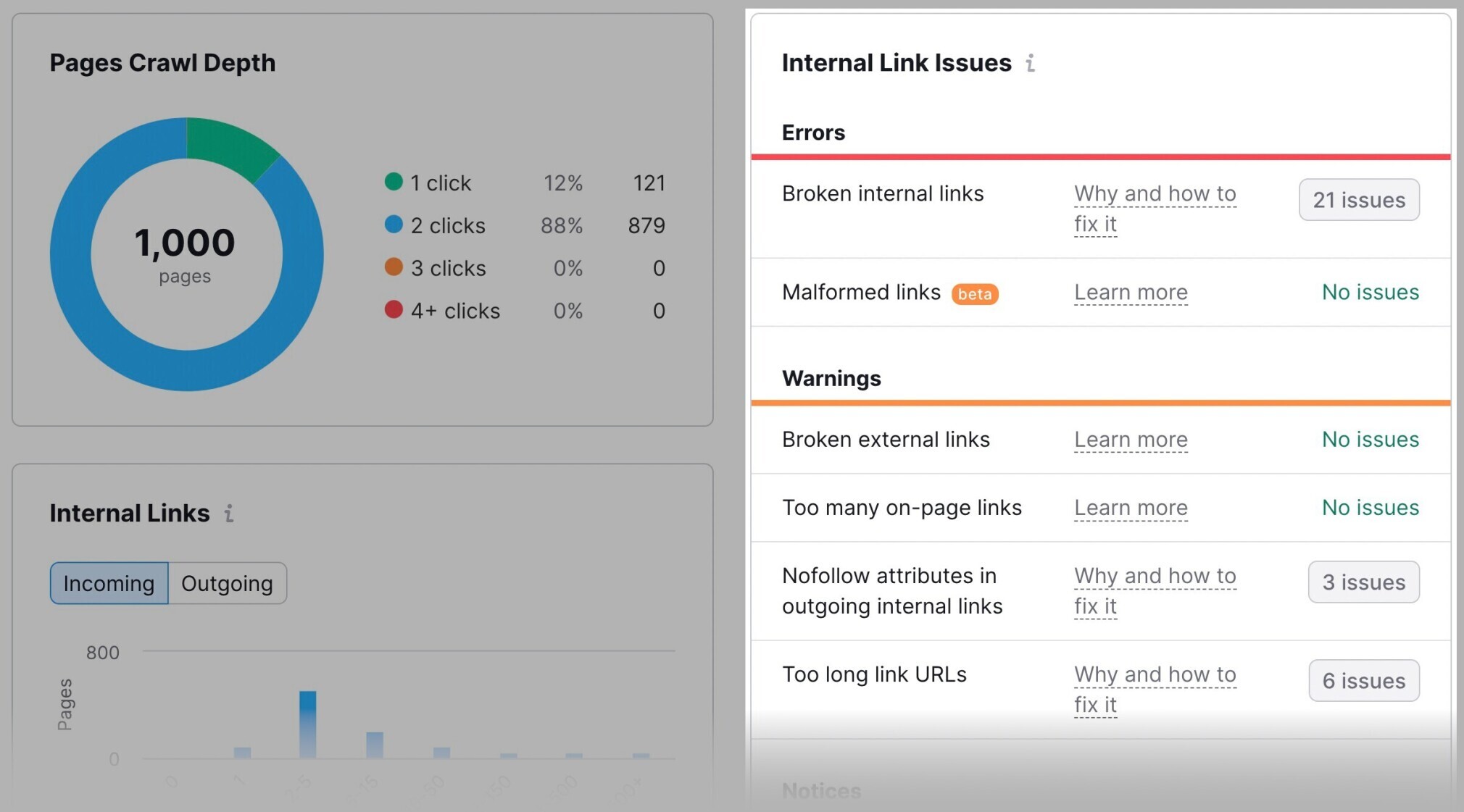
6. Improve User Experience
Google keeps a close eye on how users engage with pages. As such, user experience (UX) is a key factor in helping improve search rankings.
Page speed plays a key role in improving UX. But it’s just a starting point.
Here are a few other SEO tips to ensure that users have a good experience when they visit your site:
- Use headers & subheadings: Proper use of headers & subheadings (H1, H2, H3) helps Google understand your content better and makes your text more accessible to readers
- Make your content visually appealing: Visuals help readers understand your content better. Use relevant images, videos, and screenshots to help get your point across.
- Avoid using intrusive pop-ups: Pop-ups are annoying your visitors. Since 2017, Google has penalized sites that use intrusive pop-ups, so it’s best to use them sparingly.
- Use white space: White space is fundamental for good design. According to the Interaction Design Foundation, white space improves legibility, branding, and focus.
- Make your site mobile-friendly: Mobile-friendliness is critical when it comes to UX because Google uses mobile-first indexing. You can use Google’s mobile-friendly test to see how your site performs.
7. Make Your URLs SEO-Friendly
A good URL structure gives users and search engines an idea of what the destination page is about.
Consider organizing your content so that URLs are constructed logically. And in a manner that is most intelligible to humans.
With that in mind, here is how you can start creating well-structured URLs:
- Use short URLs: A study conducted by Backlinko found that short URLs tend to outperform long URLs in SERPs.
- Include your target keyword: Always include your target keywords in the URL to increase your chances of ranking better in search results.
- Include categories or subfolders if necessary: For example, if you’re selling goods, you may have a “shop” subcategory. This helps both users and search engines navigate your site.

8. Earn Authoritative Backlinks
Google recognizes backlinks as “votes of confidence” from other sites to yours.
If your web pages have many authoritative backlinks, they’re more likely to rank well on the SERPs.
That said, not all backlinks are created equal.
Some backlinks can boost your ranking for specific search queries exponentially, while others may be considered “toxic.”
You should focus your efforts on building high-quality backlinks that can improve your chances of ranking higher for your target keywords.
One of the most effective ways to obtain authoritative backlinks is by replicating your competitors’ link building strategies.
To start, go to Semrush’s Backlink Analytics tool.
First, enter your competitor’s domain, and go to the “Indexed Pages” tab.

You’ll see a table with all of your competitor’s pages sorted by number of referring domains (i.e., websites linking to it).
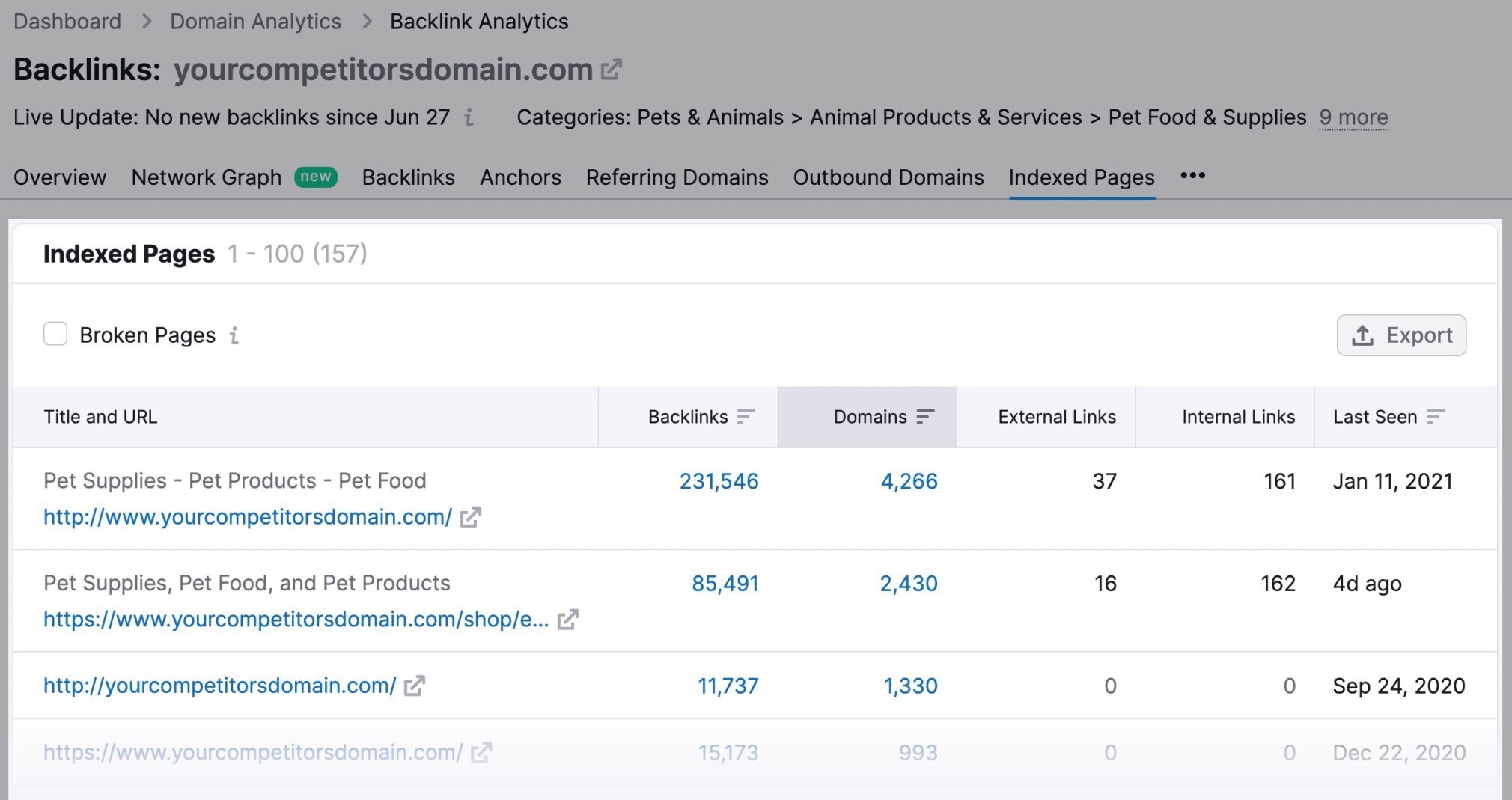
Look for patterns in the top pages’ topics, style, length, and format.
For example:
- What does your competitor write about?
- Is the format more long-form or short?
- Do they use a lot of visual assets?
The answers to these questions should guide your content strategy. Replicate what’s working in a better or similar way.
9. Create Useful Content
Publishing original, helpful content can help you rank higher on Google.
This isn’t about content length. That’s irrelevant.
Instead, strive to solve hard problems, share learnings from your data, and challenge misconceptions.
A great strategy is to find topics that are already trending in your industry. And then create content with new angles, data, and perspectives.
To quickly find trending topics, use Semrush’s Topic Research tool.
Start by entering the topic you’d like content ideas for, and then click “Get content ideas.”
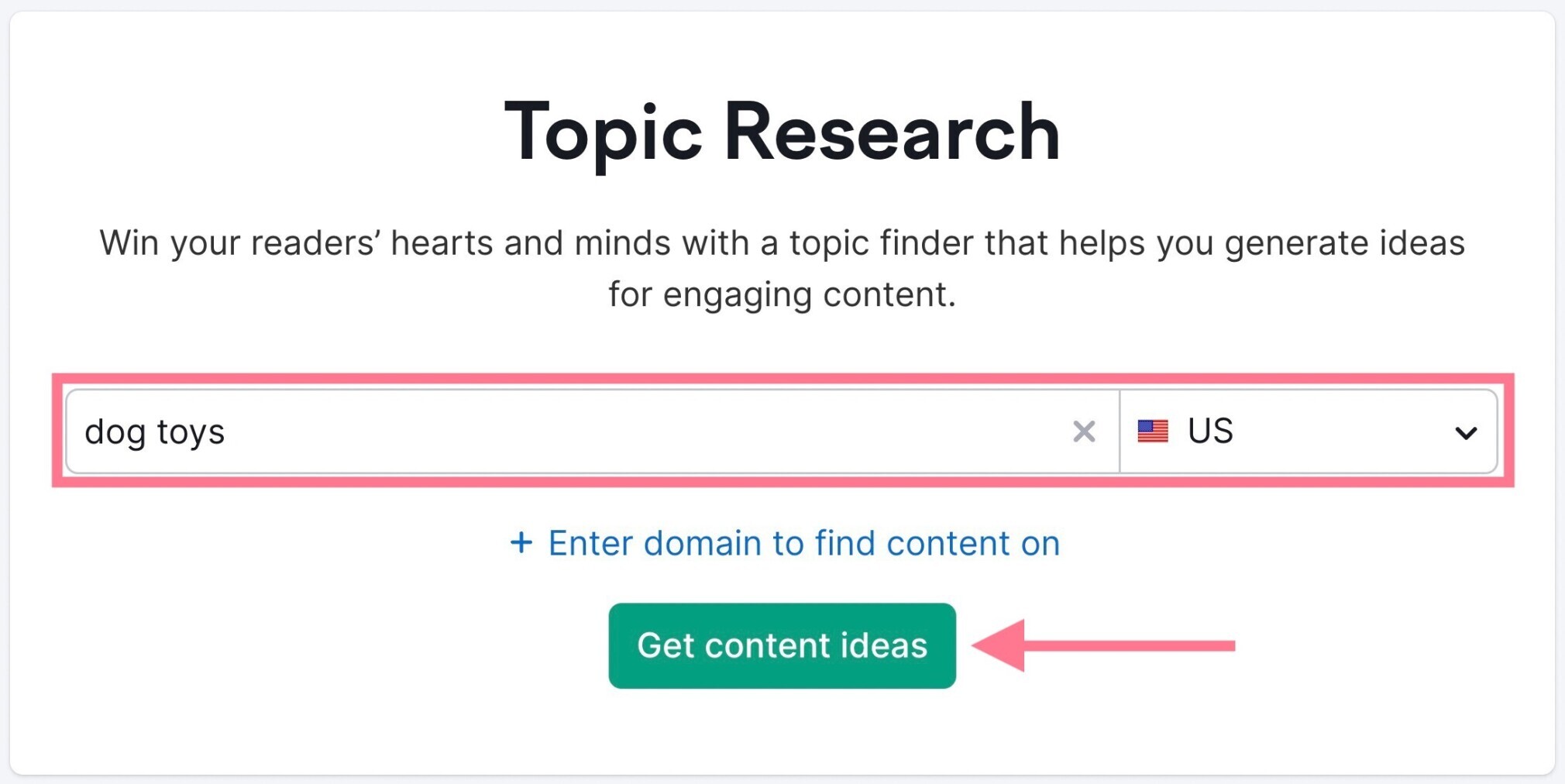
The tool will then show a vast list of potential topics. Including headlines, questions, and related searches.
All conveniently prioritized by search volume.
Like this:

FAQs
What are some common SEO best practices?
Optimizing website structure and content, using relevant and descriptive keywords, creating high-quality and valuable content, building high-quality backlinks, optimizing website speed and mobile-friendliness, and regularly updating and maintaining your website.
Will my website automatically rank well if I follow all SEO best practices?
Following SEO best practices alone does not guarantee SEO results for your website. SEO is a complex and ever-changing field. Ranking well depends on many factors, including the quality of your content, the competitiveness of your industry, and the effectiveness of your overall marketing strategy.
How should I prioritize the various SEO tasks?
Prioritizing SEO tasks can depend on several factors—the website’s goals, audience, and competition, for example. However, a good starting point is to prioritize tasks based on their potential impact on the website’s overall SEO performance.
Some high-priority tasks include improving website speed, optimizing content for target keywords, and ensuring website mobile-friendliness.
What are the most important SEO factors for my website?
The most important SEO factors may vary by type of website, industry, and other factors. But they often include keyword research and optimization, creating high-quality content, building backlinks, and ensuring that the website has a user-friendly design and structure.
What are some best practices for on-page SEO?
Some best practices for on-page SEO include optimizing your page titles, meta descriptions, header tags, and content for keywords, using descriptive and SEO-friendly URLs, and optimizing images with descriptive alt text.
What are some off-page SEO best practices?
While different marketers will have different opinions about off-page SEO tasks, some of the most common best practices include the following:
- Building high-quality backlinks from reputable websites
- Creating engaging and “link-worthy” content
- Promoting content through social media
- Participating in online communities and forums relevant to your niche
What are some best practices related to technical SEO?
Optimizing website speed and performance, using HTTPS encryption, creating an XML sitemap, and ensuring search engines can properly crawl your content are all best practices related to technical SEO.
What are the best practices for local SEO?
Some best practices for local SEO include:
- Creating a Google Business Profile listing and ensuring it is accurate and up to ****
- Consistently using accurate and consistent business information (name, address, phone number) across all online directories and listings
- Obtaining customer reviews on platforms like Google and Yelp
- Creating local content that is relevant to your target audience
- Using local keywords in your website content, title tags, and URLs
- Building local backlinks by networking with other local businesses and organizations
What are some best practices related to international SEO?
Here are some best practices related to international SEO:
- Use hreflang tags to specify language and regional targeting for your webpages
- Use country-specific top-level domains (ccTLDs) or subdomains to house your international content based on country or region
- Optimize your content for the local language and cultural preferences of your target audience
- Optimize your website’s loading speed for international audiences by using Content Delivery Networks (CDNs)
What are some best practices for SEO content creation?
Some best practices for SEO content creation include conducting keyword research to target relevant keywords, creating high-quality and original content, incorporating headers and subheaders, optimizing meta descriptions and title tags, including internal and external links, and regularly updating and refreshing content.
What internal linking best practices should I keep in mind?
Your internal linking strategy will be off to a good start if you keep the following best practices in mind:
- Link relevant pages. Only link pages that are relevant to the content on the current page.
- Use descriptive anchor text. Use descriptive and relevant anchor text that accurately describes the linked page.
- Use natural linking. Links should be natural and fit within the flow of the content.
- Keep it simple. Avoid overloading a page with too many internal links.
- Use sitemaps. Use sitemaps to cover any internal linking gaps you may have. (This can help search engines crawl and index your website.)
- Consider user experience. Make sure your internal links improve the user experience by providing additional relevant information.
What are the best practices for writing title tags?
Some best practices for writing title tags include the following:
- Keep the title tag length under 60 characters
- Include the target keyword of the page in the title tag
- Make sure the title tag accurately reflects the content on the page
- Write unique title tags for each page on your website
- Use title tags to entice clicks from search engine users
And what about for meta descriptions?
Here are some best practices to keep in mind when you’re writing meta descriptions:
- Keep them concise. Meta descriptions should ideally be between 150 and 160 characters.
- Use action-oriented language. Encourage users to click through to your website with active verbs and calls to action.
- Highlight unique selling points. Showcase what makes your content unique and why users should click on it.
- Include relevant keywords. Use relevant keywords that reflect the content of the page. While meta descriptions aren’t a ranking factor, Google may bold them in search results, making your listings stand out.
- Don’t duplicate meta descriptions. Each page should have a unique meta description that reflects its specific content.
When optimizing for page speed, what best practices should I keep in mind?
When optimizing for page speed, keep in mind the following best practices:
Keep Learning
Now that you know how to get your foundation in place, you can dive into new and more advanced SEO approaches.
Take a look at these guides to continue learning:
Source link : Semrush.com
